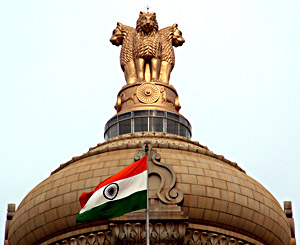All about IAS (Indian Administrative Service)
03:22AM Wed 6 Nov, 2013

 The Indian Administrative Service (abbreviated as IAS) is the administrative civil service of the Government of India. Indian Administrative Service officers hold key positions in the Union Government, State governments and Public Sector Undertakings. The Administrative Service is one of the three All India Services.The other All India Services are Indian Police Service (IPS), Indian Foreign Service (IFS) and Indian Revenue Service(IRS).[2]
The IAS officers are recruited by the Union government on the recommendation of the Union Public Service Commission (UPSC) and posted under various State governments. The officers carry high respect and stature in the society coupled with the significant task of administering public offices, making it one of the most desirable jobs in India. While the respective State Governments have control over them, they can not censure or take disciplinary action against an IAS officer or an All-India service officer, without consulting the Union Government.
The examination for getting into IAS is conducted by the UPSC. It has three stages (preliminary, mains and interview) and is considered to be extremely challenging.
Entry into the IAS is considered very difficult. Almost all of the applicants rank IAS as their top choice because of the high prestige and diversity of career it offers. For example, in the 2011 batch, of the 425 selected candidates, 370 indicated IAS as their first preference, 25 chose IFS and 15 IRS, and 15 chose IPS. But when it came to second preference, 246 candidates marked IRS as their choice, while only 120 marked IPS as their second choice and 49 as IFS.
Repeated attempts for getting entry are allowed up to four times for General Merit candidates, seven times for OBC candidates. There is no bar on the number of attempts for SC/ST candidates. The upper age limit to attempt the examination is 35 for SC/ST and 30 years for the General Merit Candidate. The candidate should not be older than 30 years of age as on 1 August of that year. The minimum age is 21 years.
About 850 candidates are finally selected each year out of the nearly 550,000 (2010 data) but only a rank in the top 80 guarantees an IAS selection – an overall acceptance rate of 0.1% and for guaranteed IAS position, acceptance rate is 0.01%. This makes it one of the most competitive selection processes in the world.
The Indian Administrative Service (abbreviated as IAS) is the administrative civil service of the Government of India. Indian Administrative Service officers hold key positions in the Union Government, State governments and Public Sector Undertakings. The Administrative Service is one of the three All India Services.The other All India Services are Indian Police Service (IPS), Indian Foreign Service (IFS) and Indian Revenue Service(IRS).[2]
The IAS officers are recruited by the Union government on the recommendation of the Union Public Service Commission (UPSC) and posted under various State governments. The officers carry high respect and stature in the society coupled with the significant task of administering public offices, making it one of the most desirable jobs in India. While the respective State Governments have control over them, they can not censure or take disciplinary action against an IAS officer or an All-India service officer, without consulting the Union Government.
The examination for getting into IAS is conducted by the UPSC. It has three stages (preliminary, mains and interview) and is considered to be extremely challenging.
Entry into the IAS is considered very difficult. Almost all of the applicants rank IAS as their top choice because of the high prestige and diversity of career it offers. For example, in the 2011 batch, of the 425 selected candidates, 370 indicated IAS as their first preference, 25 chose IFS and 15 IRS, and 15 chose IPS. But when it came to second preference, 246 candidates marked IRS as their choice, while only 120 marked IPS as their second choice and 49 as IFS.
Repeated attempts for getting entry are allowed up to four times for General Merit candidates, seven times for OBC candidates. There is no bar on the number of attempts for SC/ST candidates. The upper age limit to attempt the examination is 35 for SC/ST and 30 years for the General Merit Candidate. The candidate should not be older than 30 years of age as on 1 August of that year. The minimum age is 21 years.
About 850 candidates are finally selected each year out of the nearly 550,000 (2010 data) but only a rank in the top 80 guarantees an IAS selection – an overall acceptance rate of 0.1% and for guaranteed IAS position, acceptance rate is 0.01%. This makes it one of the most competitive selection processes in the world.
Recruitment
The direct recruitment of a candidate into IAS is by the examination conducted by UPSC as mentioned. However, recruitment into IAS is also done by appointment by selection through powers conferred by section 3 of the All India Services Act of 1951 (61 of 1951) and in pursuance of sub-rule (2) of rule 8 of the Indian Administrative Service (Recruitment) Rules of 1954 and in super-session of the Indian Administrative Service (Appointment by Selection) Regulations of 1956.
In the year 2013, UPSC has come up with the new pattern and new syllabus for conducting the IAS exam. Prior to 2013, the candidates were required to take two optional subjects but as per the new syllabus the aspirants are now required to choose only one. In the new pattern more weightage is given to the General Studies paper.
Allocation and placement
After being selected, candidates are allocated to "cadres." There is one cadre in each Indian state, except for three joint cadres:Assam–Meghalaya, Manipur–Tripura, and Arunachal Pradesh–Goa–Mizoram–Union Territories (AGMUT).[citation needed] The "insider-outsider ratio" (ratio of officers who are posted in their home states) is maintained as 1:2. as 'insiders'. The rest are posted outsiders according to the 'roster' in states other than their home states. Till 2008 there was no choice for any state cadre and the candidates, if not placed in the insider vacancy of their home states, were allotted to different states in alphabetic order of the roster, beginning with the letters A,H,M,T for that particular year. For example if in a particular year the roster begins from 'A', which means the first candidate in the roster will go to the Andhra Pradesh state cadre of IAS, the next one to Bihar, and subsequently to Chhattisgarh, Gujarat and so on in alphabetical order. The next year the roster starts from 'H', for either Haryana or Himachal Pradesh.( if it has started from Haryana in the previous occasion when it all started from 'H', then this time it would start from Himachal Pradesh). This highly intricate system has on one hand ensured that officers from different states are placed all over India, it has also resulted in wide disparities in the kind of professional exposure for officers, when we compare officers in small and big and also developed and backward state, since the system ensures that the officers are permanently placed to one state cadre. The only way the allotted state cadre can be changed is by marriage to an officer of another state cadre of IAS/IPS/IFS. One can even go to his home state cadre on deputation for a limited period, after which one has to invariably return to the cadre allotted to him or her.[citation needed] The centralising effect of these measures was considered extremely important by the system's framers, but has received increasing criticism over the years. In his keynote address at the 50th anniversary of the Service in Mussoorie, former Cabinet Secretary Nirmal Mukarji argued that separate central, state and local bureaucracies should eventually replace the IAS as an aid to efficiency.[5] There are also concerns that without such reform, the IAS will be unable to "move from a command and control strategy to a more interactive, interdependent system".[6]Functions of the civil servant/Officer[edit]
A civil servant is responsible for the law and order and general administration in the area under his work. Typically the functions of an IAS officer are as follows:[7]- To handle the daily affairs of the government, including framing and implementation of policy in consultation with the minister-in-charge of the concerned ministry.[7]
- Implementation of policy requires supervision.
- Implementation requires travelling to places where the policies are being implemented.
- Implementation also includes expenditure of public funds which again requires personal supervision as the officers are answerable to the Parliament and State Legislature for any irregularities that may occur.
- In the process of policy formulation and decision making, officers at various levels like joint secretary, deputy secretary make their contributions and the final shape to the policy is given or a final decision is taken with the concurrence of the minister concerned or the cabinet depending upon the gravity the issue.[7]
Designations

Salary structure
| Grade | Position in the State Government(s) or Central government | Pay Scale |
|---|---|---|
| Cabinet Secretary Grade | Cabinet Secretary of India | |
| Apex Scale | Chief Secretary of States, Union Secretaries in charge of various ministries of Government of India | |
| Above Super Time Sc | Principal Secretaries/Financial Commissioners in states, Additional Secretaries to the Government of India | |
| Super Time Scale | Secretary in state government or position of Joint Secretary to the Government of India or Divisional Commissioners | |
| Selection Grade | District collector or Special Secretary in the state government or a Director in the central government | |
| Junior Administrative Grade | District collector or the Municipal Commissioner or a Deputy Secretary in the central government | |
| Senior Time Scale | Chief Development Officer in District or Joint Secretary in State or Under Secretary in Central government | |
| Junior Time Scale | Sub-Divisional Magistrate (Entry) |











